Bengal or Rock Eagle Owl
Bengal or Rock Eagle Owl
Bubo bengelensis
Bengal Eagle Owls are also know as Rock Eagle Owls or Indian Eagle Owls. They were once considered a subspecies of the Eurasian Eagle Owl.
Description: Dark and light morphs of this bird occur.
The facial disc is fulvous-brown to buffy, with a prominent blackish rim. The eyebrows are start out whitish at the centre of the face, and change to a blackish line at a point just above the centre of each eye, and then continue up to the dark ear tufts. the Forehead is buffy brown, with small blackish flecks, which become greater in number towards the crown, giving it a dark appearance. Eyes are Orange-yellow to orange-red, and the bill greenish-horn to slate-black. The Chin and throat are white.
Upperparts are tawny brown, mottled and streaked with blackish brown. There is often a whitish bar across the shoulder.
Wing and Tail feathers are tawny-buff, barred with blackish brown.
Lowerparts are fulvous, becoming whitish near the centre. The upper breast has small, dark streaks, with the rest of the underparts having fine streaks and faint cross-bars, which become fainter towards the abdomen.
Legs and toes are feathered fulvous, with the outer joints of the toes being bare, and a greenish-slate colour. The claws are dusky black.
Bengal Eagle Owls are mostly nocturnal. They fly with slow, deliberate wingbeats, with long bouts of gliding.
Size: Length 50-56 cm (19.7-22″)
Wing Length Male 364-390mm (14.3-15.4″) Female 375-425mm (14.8-16.7″)
Weight 1100g (38.8oz) (weight of one male specimen)
Voice: Male has a deep, resonant, double hoot bu-whooh, repeated at intervals of several seconds. The female’s song is similar, with a slightly higher pitch. At the nest both sexes with may make a clucking noise, or a series of huwoo-huwoo sounds – again, the female is slightly higher in pitch.
Hunting & Food: Bengal Eagle Owls usually hunt from a perch, but will also make low foraging flights to dive on prey. They primarily hunt rats and mice, but will also take birds up to the size of peafowl. They will also eat reptiles, frogs, crabs and large insects.
Pellets are up to 150 x 40mm (5.9 x 1.6″)
Breeding: Similar to Eurasian Eagle Owl.
Generally, these Owls will breed from February to April, but this may vary locally between October and May.
The nest is usually a shallow scrape on bare earth. This may be on a protected rock ledge, river bank, or a recess in a cliff that is in a ravine. They have also been known to nest on the ground under a bush, or between rocks on a slope.
2-4 white eggs are laid, averaging 53.6 x 43.8mm (2.1 x 1.7″). They are incubated by the female for 35 days.
Mortality: Uncertain, probably similar to Eurasian Eagle Owl
Habitat: Rocky Hills with bushes, earth banks, wooded county with ravines, semi-deserts with rocks and bushes.
They have been known to inhabit old Mango orchards close to human populations.
Distribution: West Himalayas, Pakistan, throughout India, Kashmir, Nepal, Assam and Burma.

